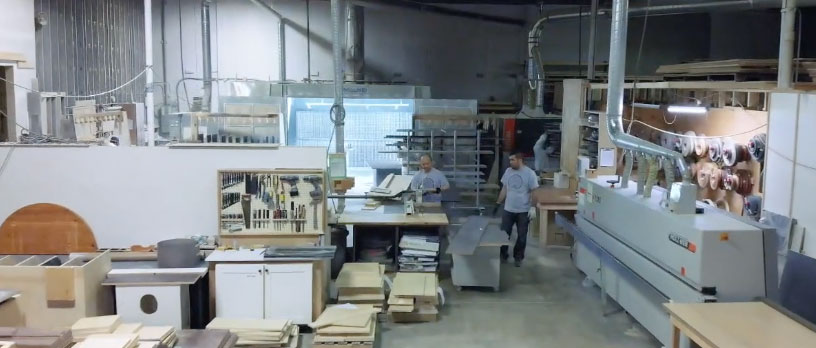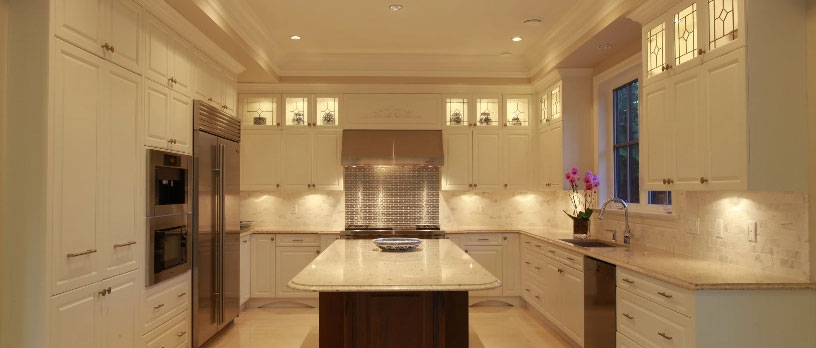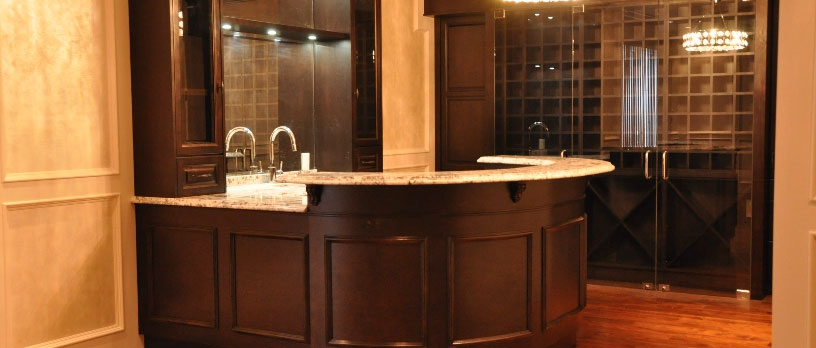Kitchen cabinets are a significant investment, both financially and aesthetically and to take care of kitchen cabinets shouldn’t be expensive OR difficult. They play a vital role in the functionality and style of your kitchen, and proper care can ensure they last for many years. Here are some tips on how to care for your kitchen cabinets:
- Clean regularly with mild soap and water.
- Address spills promptly to avoid stains.
- Deep clean every few months, ensuring thorough drying.
- Use furniture wax on wood and gentle cleaners on painted cabinets.
- Prevent damage with coasters, placemats, and by controlling moisture.
How to Take Care of Kitchen Cabinets: Cleaning & Maintenance

Choosing the right cleaning solution to Take Care of Kitchen Cabinets:
- Mild soap and water: This is the safest and most recommended solution for most kitchen cabinet finishes. A few drops of mild dish soap mixed with warm water should suffice for regular cleaning.
- Vinegar for stubborn stains: For tougher grime or sticky residues, a solution of equal parts white vinegar and water can be an effective remedy. Apply the solution to a microfiber cloth, wipe the affected area, and then rinse with clean water and dry thoroughly.
- Avoid harsh chemicals: Steer clear of abrasive cleaners, ammonia, bleach, and furniture polishes. These products can damage the finish of your cabinets, causing fading, dulling, or even cracking over time.
Regular cleaning:
Wipe down your cabinets regularly with a damp microfiber cloth. Avoid using harsh chemicals or abrasive cleaners are not going to help you take care of kitchen cabinets, as these can damage the finish. A mild soap and water solution is usually sufficient.
Deep Cleaning: A Seasonal Refresh
While regular wiping suffices most of the time to take care of kitchen cabinets, a deeper clean is necessary every 3-4 months. Here’s what you need to do:
- Empty the cabinets: Take everything out to ensure thorough cleaning of all surfaces.
- Focus on details: Use a damp microfiber cloth with your chosen cleaning solution to wipe down the shelves, doors (both front and back), drawers, and hardware. For hard-to-reach areas like corners and crevices, a clean toothbrush dipped in the cleaning solution can be helpful.
- Pay attention to ventilation: After cleaning, leave the cabinet doors and drawers open for a while to allow everything to dry completely. This prevents moisture build-up and potential mold growth.
- Dealing with spills: Act quickly to clean up spills to prevent them from staining or damaging them, and take care of kitchen cabinets. Blot up the spill with a clean, absorbent cloth. Do not rub, as this can spread the spill. If the spill is sticky, you can use a damp cloth with a mild soap and water solution to clean it.
Remember, cleaning kitchen cabinets often involves simple, regular cleaning, especially if you address spills quickly.
NKBA also provides detailed cleaning recommendations for different cabinet materials.
Maintaining the finish of your Kitchen cabinets:
- Wood cabinets:
- Apply a coat of wood furniture wax about twice a year to create a protective barrier against debris, oil, and grime.
- Avoid using harsh chemicals or abrasive cleaners, as they can damage the wood.
- Painted cabinets:
- Use a gentle cleaning solution, such as a mixture of mild dish soap and water, to avoid stripping the paint.
- Avoid using ammonia-based cleaners, as they can dull the paint finish.
Additional tips:
- Control moisture:
- Address spills immediately to prevent water damage.
- Avoid storing wet items in your cabinets.
- Ensure proper ventilation in your kitchen to prevent moisture buildup.
- Prevent scratches and dents:
- Use cutting boards on countertops to avoid damaging cabinet surfaces.
- Place placemats under hot dishes to prevent heat damage.
- Be careful when opening and closing cabinet doors to avoid slamming them shut.
Preventing Damage to Kitchen Cabinets
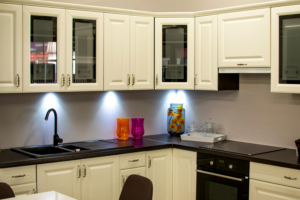
Preventing Damage to Kitchen Cabinets: A Deeper Dive
To take care of kitchen cabinets isn’t just about cleaning – it’s about these preventive steps too, while the previous section listed some crucial preventative measures, let’s delve deeper into understanding the “whys” and “hows” of each point:
1. Minimizing Moisture Exposure:
-
Understanding the threat: Water is a major culprit behind several cabinet issues. It can cause:
- Warping: Constant exposure to moisture can cause the wood to swell and shrink, leading to warped cabinets that appear uneven or misaligned.
- Cracking: As the wood expands and contracts due to moisture fluctuations, cracks can develop on the surface, compromising the cabinet’s integrity.
- Mildew and mold growth: Moisture creates a breeding ground for mold and mildew, which can not only damage the cabinets but also pose health risks.
-
Prevention strategies:
- Minimize splashing: While cooking, be mindful of water splashing onto your cabinets. Use a splash guard behind your sink to offer an extra layer of protection.
- Wipe spills promptly: Don’t let spills sit. Immediately blot up excess liquid with a clean, absorbent cloth. Follow up with a damp microfiber cloth and your chosen cleaning solution to ensure complete removal.
- Address leaks promptly: Leaky faucets or pipes can cause significant water damage to cabinets. Fix any leaks as soon as possible to prevent further problems.
2. Utilizing Coasters and Placemats:
- Protecting against heat damage: Extreme heat from hot dishes can cause discoloration, warping, and even burn marks on cabinet surfaces. Coasters act as a barrier between the hot dish and the cabinet, preventing heat transfer and potential damage.
- Preventing scratches: Utensils and cutlery can scratch the surface of your cabinets, especially on countertops. Placemats provide a protective layer between your plates and the countertop, preventing such scratches from transferring to the cabinets below.
- Choosing the right materials: Opt for coasters and placemats made from heat-resistant and absorbent materials like cork, silicone, or fabric.
3. Storing Items Wisely:
- Preventing strain on hinges and doors: Overloading your cabinets can put excessive stress on the hinges and doors, causing them to weaken, sag, or even break over time.
- Distributing weight evenly: Distribute the weight of your stored items uniformly. Avoid placing all the heavy items in one section of the cabinet, as this can lead to uneven pressure and potential damage.
- Choosing appropriate storage solutions: Consider using shelving dividers or organizers to distribute weight more evenly and keep items in place while avoiding overloading.
- Understanding weight limitations: Most cabinets have weight capacity limitations. Consult your kitchen cabinets manual or manufacturer’s information to understand the recommended weight limit for your specific cabinets.
4. Ensuring Proper Ventilation:
- Combating moisture buildup: Proper ventilation helps remove moisture from the kitchen air, preventing it from accumulating on your cabinets and causing damage.
- Promoting air circulation: Open windows while cooking or use exhaust fans to remove steam and excess moisture from the kitchen.
- Addressing humidity issues: If your kitchen tends to be particularly humid, consider using a dehumidifier to control moisture levels and prevent cabinet damage.
Additional Tips for Lasting Beauty and Take Care of Kitchen Cabinets:
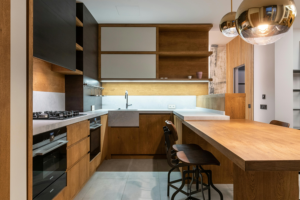
Here are some additional practices to take care of kitchen cabinets and keep them looking their best:
- Dust regularly: Dust buildup can dull the surface of your kitchen cabinets. Regularly dust them with a soft, dry cloth to maintain their shine.
- Sharpen knives: Dull knives can damage your cabinets when used for cutting on countertops. Sharpen your knives regularly to prevent such accidents.
- Touch up minor imperfections: If your cabinets have minor nicks or scratches, you can touch them up with a furniture repair kit. This is a quick and easy way to restore their appearance.
- Refinish when necessary: Over time, your cabinets may show signs of wear and tear. If the damage is significant, consider refinishing them. This is a more involved process, but it can be a cost-effective way to revitalize your cabinets and breathe new life into your kitchen.
- Consider using cabinet liners: Kitchen cabinets liners can help to protect your cabinets from scratches, stains, and moisture damage.
- Invest in high-quality hardware: The hardware on your kitchen cabinets, such as hinges and knobs, can also make a big difference in their appearance and functionality. Choose high-quality hardware that is durable and stylish.
- Clean up spills immediately: The sooner you clean up a spill, the less likely it is to damage your cabinets.
- Avoid using abrasive cleaners: Abrasive cleaners can scratch the finish of your cabinets. Stick to mild soap and water or a vinegar solution.
- Be careful when cutting on your cabinets: Use a cutting board to protect your cabinets from knife marks.
- Dust your cabinets regularly: Dust can build up on your kitchen cabinets over time, making them look dull. Dust them regularly with a soft cloth.
- Refinish your cabinets when necessary: If your kitchen cabinets are starting to look worn or damaged, you may consider refinishing them. This can be a great way to update the look of your kitchen.


